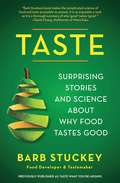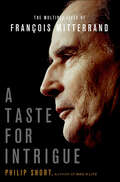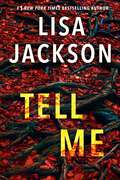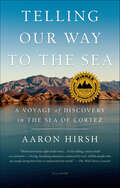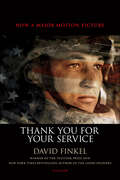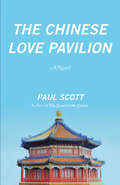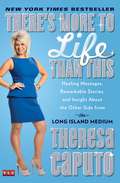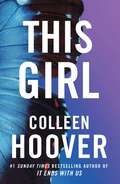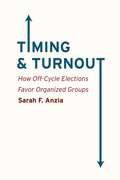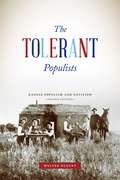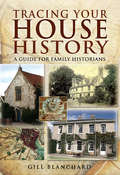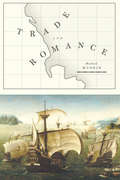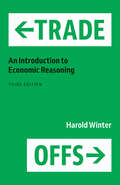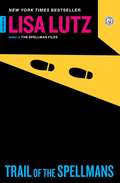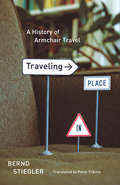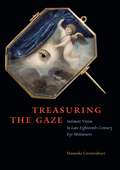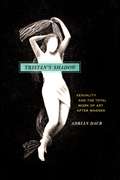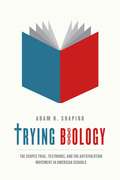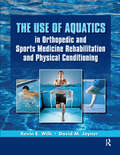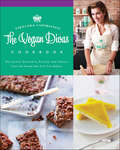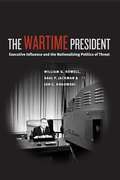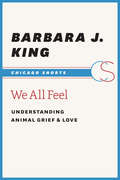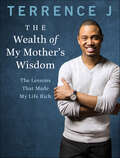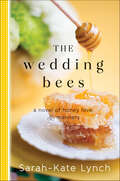- Table View
- List View
Taste: Surprising Stories and Science About Why Food Tastes Good
by Barb StuckeyWhether it&’s a grilled cheese sandwich with tomato soup or a salted caramel coated in dark chocolate, you know when food tastes good—now here&’s the amazing story behind why you love some foods and can&’t tolerate others.Through fascinating stories from Barb Stuckey—a seasoned food developer to whom food companies turn for help in creating delicious new products—you&’ll learn how our five senses work together to form flavor perception and how the experience of food changes for people who have lost their sense of smell or taste. You&’ll learn why kids (and some adults) turn up their noses at Brussels sprouts, how salt makes grapefruit sweet, and why you drink your coffee black while your spouse loads it with cream and sugar. Eye-opening experiments allow you to discover your unique &“taster type&” and to learn why you react instinctively to certain foods. You&’ll improve your ability to discern flavors and devise taste combinations in your own kitchen for delectable results. What Harold McGee did for the science of cooking Barb Stuckey does for the science of eating in Taste—a calorie-free way to get more pleasure from every bite.
A Taste for Intrigue: The Multiple Lives of François Mitterrand
by Philip ShortThe man who changed the course of modern FranceIn 1981, François Mitterrand became France's first popularly elected socialist president. By the time he completed his mandate, he had led the country for 14 years, longer than any other French head of state in modern times. Mitterrand mirrored France in all its imperfections and tragedies, its cowardice and glory, its weakness and its strength.In the wake of the Observatory affair (in which he orchestrated his own assassination attempt), his secretiveness and mistrust grew more pronounced, especially when details of a second family came to light; he was a mixture of "Machiavelli, Don Corleone, Casanova and the Little Prince," said his doctor.During the German occupation, Mitterrand hedged his bets by joining Petain's Vichy government. Later in 1943, under the nom de guerre of Morland (and 30 other aliases), Mitterrand quit Vichy for the Resistance and a paramilitary organization.He changed the ground rules of French social and political debate in ways more far-reaching and fundamental than any other modern leader before him, helping set the agenda for France and Europe for generations to come. Philip Short's A Taste for Intrigue will fill the gap and become the standard against which all other Mitterrand biographies are set.
Tell Me (Pierce Reed/Nikki Gillette #3)
by Lisa JacksonWhen Savannah, Georgia&’s most hated woman is set free, one mother&’s long ago crime ignites a new killing spree in #1 New York Times bestselling author Lisa Jackson&’s blockbuster Southern thriller featuring crime writer Nikki Gillette and Detective Pierce Reed. Now in paperback and perfect for fans of Melinda Leigh, Sandra Brown, and Lisa Gardner. The most hated woman in Savannah, Georgia, is about to be set free. Twenty years ago, Blondell O&’Henry was convicted of murdering her eldest daughter, Amity, and wounding her two other children. The prosecution argued that beautiful, selfish Blondell wanted to be rid of them to be with her lover. But Blondell&’s son has now recanted his testimony and demolished the case in the process . . . Reporter Nikki Gillette is determined to get the truth, and not just for professional reasons. Amity was Nikki&’s childhood friend. The night she died, Amity begged Nikki to meet with her, insisting she had a secret to tell, but Nikki didn&’t go. Wracked with guilt, as Nikki digs for answers, her fiancé, Detective Pierce Reed, worries for her safety. Everyone involved seems to have secrets. And somehow, the events of that tragic night connect to Nikki&’s own fractured family. But now the killing has begun again. Is Amity&’s murderer still at large, or is this a new, darker danger? Soon Nikki will discover what really happened twenty years ago, but the answers may come too late to save her life . . .
Telling Our Way to the Sea: A Voyage of Discovery in the Sea of Cortez
by Aaron HirshA luminous and revelatory journey into the science of life and the depths of the human experienceBy turns epic and intimate, Telling Our Way to the Sea is both a staggering revelation of unraveling ecosystems and a profound meditation on our changing relationships with nature—and with one another.When the biologists Aaron Hirsh and Veronica Volny, along with their friend Graham Burnett, a historian of science, lead twelve college students to a remote fishing village on the Sea of Cortez, they come upon a bay of dazzling beauty and richness. But as the group pursues various threads of investigation—ecological and evolutionary studies of the sea, the desert, and their various species of animals and plants; the stories of local villagers; the journals of conquistadors and explorers—they recognize that the bay, spectacular and pristine though it seems, is but a ghost of what it once was. Life in the Sea of Cortez, they realize, has been reshaped by complex human ideas and decisions—the laws and economics of fishing, property, and water; the dreams of developers and the fantasies of tourists seeking the wild; even efforts to retrieve species from the brink of extinction—all of which have caused dramatic upheavals in the ecosystem. It is a painful realization, but the students discover a way forward. After weathering a hurricane and encountering a rare whale in its wake, they come to see that the bay's best chance of recovery may in fact reside in our own human stories, which can weave a compelling memory of the place. Glimpsing the intricate and ever-shifting web of human connections with the Sea of Cortez, the students comprehend anew their own place in the natural world—suspended between past and future, teetering between abundance and loss. The redemption in their difficult realization is that as they find their places in a profoundly altered environment, they also recognize their roles in the path ahead, and ultimately come to see one another, and themselves, in a new light.In Telling Our Way to the Sea, Hirsh's voice resounds with compassionate humanity, capturing the complex beauty of both the marine world he explores and the people he explores it with. Vibrantly alive with sensitivity and nuance, Telling Our Way to the Sea transcends its genre to become literature.
Thank You for Your Service
by David FinkelNow a Major Motion Picture Directed by American Sniper Writer Jason Hall and Starring Miles Teller No journalist has reckoned with the psychology of war as intimately as David Finkel. In The Good Soldiers, his bestselling account from the front lines of Baghdad, Finkel embedded with the men of the 2-16 Infantry Battalion as they carried out the infamous “surge”. Now, in Thank You for Your Service, Finkel tells the true story of those men as they return home from the front-lines of Baghdad and struggle to reintegrate--both into their family lives and into American society at large. Finkel is with these veterans in their most intimate, painful, and hopeful moments as they try to recover, and in doing so, he creates an indelible, essential portrait of what life after war is like--not just for these soldiers, but for their wives, widows, children, and friends, and for the professionals who are truly trying, and to a great degree failing, to undo the damage that has been done. Thank You for Your Service is an act of understanding, and it offers a more complete picture than we have ever had of two essential questions: When we ask young men and women to go to war, what are we asking of them? And when they return, what are we thanking them for? “Finkel sketches a panoramic view of postwar life....A book that every American should read.” —Jake Tapper, Los Angeles Times Finalist for the National Book Critics Circle Award, the Los Angeles Times Book Prize, and the New York Public Library Helen Bernstein Award for Excellence in Journalism. One of Ten Favorite Books of 2013 by Michiko Kakutani (The New York Times), a Washington Post Top Ten Book of the Year, and a New York Times Book Review Notable Book of the Year
The The Chinese Love Pavilion: A Novel
by Paul ScottPaul Scott is most famous for his much-beloved tetralogy The Raj Quartet, an epic that chronicles the end of the British rule in India with a cast of vividly and memorably drawn characters. Inspired by Scott’s own time spent in India and Malaya during World War II, this two powerful novel provides valuable insight into how foreign lands changed the British who worked and fought in them, hated and loved them. The Chinese Love Pavilion follows a young British clerk, Tom Brent, who must track down a former friend—now suspected of murder—in Malaya. Tom faces great danger, both from the mysterious Malayan jungles and the political tensions between British officers, but the novel is perhaps most memorable for the strange, beautiful romance between Tom and a protean Eurasian beauty whom he meets in the eponymous Chinese Love Pavilion.
There's More to Life Than This: Healing Messages, Remarkable Stories, and Insight About the Other Side from the Long Island Medium (A Gift for Long Island Medium Fans)
by Theresa CaputoFor fans of TLC’s Long Island Medium and anyone interested in the big questions of life, death, and finding out what’s important in between, New York Times bestselling author and medium Theresa Caputo shares how she discovered her gift and her many encounters with Spirit.Beloved medium Theresa Caputo, star of the hit television show Long Island Medium, opens the door to her world and invites you to experience her exceptional gift of communicating with those who’ve crossed over to the Other Side. The always funny, frank, and down-to-earth medium—whether she’s talking to her family, the local butcher, or the souls of those who’ve passed on—began communicating with Spirit at the age of four, but didn’t fully accept her gift until she was thirty-three years old. She had a good life as a busy wife and working mom, but also suffered from chronic anxiety that, as it turned out, came from ignoring her abilities. Once Theresa began channeling, she realized that she felt much better after delivering a message from Spirit and releasing that energy. Since then she’ s used her extraordinary gift to help people heal from the loss of their loved ones. Theresa feels that it’s her purpose to make us all aware that there is more to life than what we see here in the physical world. She wants you to know that your deceased loved ones are safe and at peace, and that they’re now with you in a different way—watching over you, loving you, and assisting you from the Other Side. She also wants you to realize that the unexplainable things you sense and feel from these souls are real, and that it’s healthy and essential to acknowledge them. There’s More to Life Than This lends insight on how Theresa’s mediumship works, what happens to your soul when you die, what Spirit says Heaven is like, what the deceased want you to know, the importance of living a positive life, and the many roles that your family, friends, angels, guides, souls of faith, and God play here and in the afterlife. It also explores how to safely connect with Spirit, so that you can recognize when your loved ones are reaching out. Through Theresa’s personal story, compelling anecdotes, and fascinating client readings, she teaches us about how she communicates with Spirit and helps us to understand and appreciate the important lessons and touching messages that we’re meant to embrace every day.
This Girl
by Colleen HooverFrom the New York Times bestselling author of It Ends With Us, Colleen Hoover&’s bestselling Slammed series comes to its gripping conclusion. There are two sides to every love story. Now hear Will&’s. Layken and Will&’s love has managed to withstand the toughest of circumstances, and the young lovers, now married, are beginning to feel safe and secure in their union. As much as Layken relishes their new life together, she finds herself wanting to know everything there is to know about her husband, even though Will makes it clear he prefers to keep the painful memories of the past where they belong. Still, he can&’t resist his wife&’s pleas, and so he begins to untangle his side of the story, revealing for the first time his most intimate feelings and thoughts, retelling both the good and bad moments, and sharing a few shocking confessions of his own from the time when they first met.In This Girl, Will tells the story of their complicated relationship from his point of view. Their future rests on how well they deal with the past in this final instalment of the beloved Slammed series.
Timing & Turnout: How Off-Cycle Elections Favor Organized Groups
by Sarah F. AnziaPublic policy in the United States is the product of decisions made by more than 500,000 elected officials, and the vast majority of those officials are elected on days other than Election Day. And because far fewer voters turn out for off-cycle elections, that means the majority of officials in America are elected by a politically motivated minority of Americans. Sarah F. Anzia is the first to systemically address the effects of election timing on political outcomes, and her findings are eye-opening. The low turnout for off-cycle elections, Anzia argues, increases the influence of organized interest groups like teachers’ unions and municipal workers. While such groups tend to vote at high rates regardless of when the election is held, the low turnout in off-cycle years enhances the effectiveness of their mobilization efforts and makes them a proportionately larger bloc. Throughout American history, the issue of election timing has been a contentious one. Anzia’s book traces efforts by interest groups and political parties to change the timing of elections to their advantage, resulting in the electoral structures we have today. Ultimately, what might seem at first glance to be mundane matters of scheduling are better understood as tactics designed to distribute political power, determining who has an advantage in the electoral process and who will control government at the municipal, county, and state levels.
The Tolerant Populists: Kansas Populism and Nativism
by Walter NugentA political movement rallies against underregulated banks, widening gaps in wealth, and gridlocked governments. Sound familiar? More than a century before Occupy Wall Street, the People’s Party of the 1890s was organizing for change. They were the original source of the term “populism,” and a catalyst for the later Progressive Era and New Deal. Historians wrote approvingly of the Populists up into the 1950s. But with time and new voices, led by historian Richard Hofstadter, the Populists were denigrated, depicted as demagogic, conspiratorial, and even anti-Semitic. In a landmark study, Walter Nugent set out to uncover the truth of populism, focusing on the most prominent Populist state, Kansas. He focused on primary sources, looking at the small towns and farmers that were the foundation of the movement. The result, The Tolerant Populists, was the first book-length, source-based analysis of the Populists. Nugent’s work sparked a movement to undo the historical revisionism and ultimately found itself at the center of a controversy that has been called “one of the bloodiest episodes in American historiography.” This timely re-release of The Tolerant Populists comes as the term finds new currency—and new scorn—in modern politics. A definitive work on populism, it serves as a vivid example of the potential that political movements and popular opinion can have to change history and affect our future.
Tracing Your House History: A Guide For Family Historians (Tracing Your Ancestors)
by Gill Blanchard“With its practical slant and focus on demystifying unfamiliar property documents, this is the perfect introduction to tracing a house history.” —Family Tree MagazineAnyone who wants to find out about the history of their house—of their home—needs to read this compact, practical handbook. Whether you live in a manor house or on a planned estate, in a laborer’s cottage, a tied house, a Victorian terrace, a twentieth-century council house or a converted warehouse—this is the book for you. In a series of concise, information-filled chapters, Gill Blanchard shows you how to trace the history of your house or flat, how to gain an insight into the lives of the people who lived in it before you, and how to fit it into the wider history of your neighborhood.A wealth of historical evidence is available in libraries, archives and record offices, in books and online, and this is the ideal introduction to it. Gill Blanchard explores these resources in depth, explains their significance and directs the researcher to the most relevant, and revealing, aspects of them. She makes the research process understandable, accessible and fun, and in the process, she demystifies the sometimes-obscure language and layout of the documents that researchers will come up against.“This book is more than a guide to researching the history of your house, or a house of interest. It is a font of interest if you are seeking to research and understand the social and domestic lives of people and their communities from early times.” —Federation of Family History Societies
Trade and Romance
by Michael MurrinIn Trade and Romance, Michael Murrin examines the complex relations between the expansion of trade in Asia and the production of heroic romance in Europe from the second half of the thirteenth century through the late seventeenth century. He shows how these tales of romance, ostensibly meant for the aristocracy, were important to the growing mercantile class as a way to gauge their own experiences in traveling to and trading in these exotic locales. Murrin also looks at the role that growing knowledge of geography played in the writing of the creative literature of the period, tracking how accurate, or inaccurate, these writers were in depicting far-flung destinations, from Iran and the Caspian Sea all the way to the Pacific. With reference to an impressive range of major works in several languages—including the works of Marco Polo, Geoffrey Chaucer, Matteo Maria Boiardo, Luís de Camões, Fernão Mendes Pinto, Edmund Spenser, John Milton, and more—Murrin tracks numerous accounts by traders and merchants through the literature, first on the Silk Road, beginning in the mid-thirteenth century; then on the water route to India, Japan, and China via the Cape of Good Hope; and, finally, the overland route through Siberia to Beijing. All of these routes, originally used to exchange commodities, quickly became paths to knowledge as well, enabling information to pass, if sometimes vaguely and intermittently, between Europe and the Far East. These new tales of distant shores fired the imagination of Europe and made their way, with surprising accuracy, as Murrin shows, into the poetry of the period.
Trade-Offs: An Introduction to Economic Reasoning
by Harold WinterThe highly engaging introduction to thinking like an economist, updated for a new generation of readers.When economists wrestle with any social issue—be it unemployment, inflation, healthcare, or crime and punishment—they do so impersonally. The big question for them is: what are the costs and benefits, or trade-offs, of the solutions to such matters? These trade-offs constitute the core of how economists see the world—and make the policies that govern it.Trade-Offs is an introduction to the economic approach of analyzing controversial policy issues. A useful introduction to the various factors that inform public opinion and policymaking, Trade-Offs is composed of case studies on topics drawn from across contemporary law and society.Intellectually stimulating yet accessible and entertaining, Trade-Offs will be appreciated by students of economics, public policy, health administration, political science, and law, as well as by anyone following current social policy debates.
Trail of the Spellmans: Document #5 (The Spellman Series #5)
by Lisa LutzThe fifth in the critically acclaimed, New York Times bestselling, Edgar Award–nominated series about a fearless private investigator Izzy Spellman and her quirky, yet endearing, family of sleuths: &“Lie back and enjoy this tale of intergenerational gumshoe mayhem&” (Kirkus Reviews).For the first time in Spellman history, Isabel Spellman, PI, might be the most normal member of her family. Mom has taken on an outrageous assortment of extracurricular activities—with no apparent motive. Dad has a secret. Izzy&’s brother and sister are at war—for no apparent reason. And her niece keeps saying &“banana&” even though she hates bananas. That&’s not to say that Izzy isn&’t without her own troubles. Her boyfriend, Henry Stone, keeps wanting &“to talk,&” a prospect Isabel evades by going out with her new drinking buddy, none other than Gertrude Stone, Henry&’s mother. Things aren&’t any simpler on the business side of Spellman Investigations. First, Rae is hired to follow a girl, but then fakes the surveillance reports. Then a math professor hires Izzy to watch his immaculate apartment while he unravels like a bad formula. And as the questions pile up, Izzy won&’t stop hunting for the answers—even when they threaten to shatter both the business and the family.
Traveling in Place: A History of Armchair Travel
by Bernd StieglerArmchair travel may seem like an oxymoron. Doesn’t travel require us to leave the house? And yet, anyone who has lost herself for hours in the descriptive pages of a novel or the absorbing images of a film knows the very real feeling of having explored and experienced a different place or time without ever leaving her seat. No passport, no currency, no security screening required—the luxury of armchair travel is accessible to us all. In Traveling in Place, Bernd Stiegler celebrates this convenient, magical means of transport in all its many forms. Organized into twenty-one “legs”—or short chapters—Traveling in Place begins with a consideration of Xavier de Maistre’s 1794 Voyage autour de ma chambre, an account of the forty-two-day “journey around his room” Maistre undertook as a way to entertain himself while under house arrest. Stiegler is fascinated by the notion of exploring the familiar as though it were completely new and strange. He engages writers as diverse as Roussel, Beckett, Perec, Robbe-Grillet, Cortázar, Kierkegaard, and Borges, all of whom show how the everyday can be brilliantly transformed. Like the best guidebooks, Traveling in Place is more interested in the idea of travel as a state of mind than as a physical activity, and Stiegler reflects on the different ways that traveling at home have manifested themselves in the modern era, from literature and film to the virtual possibilities of the Internet, blogs, and contemporary art. Reminiscent of the pictorial meditations of Sebald, but possessed of the intellectual playfulness of Calvino, Traveling in Place offers an entertaining and creative Baedeker to journeying at home.
Treasuring the Gaze: Intimate Vision in Late Eighteenth-Century Eye Miniatures
by Hanneke GrootenboerThe end of the eighteenth century saw the start of a new craze in Europe: tiny portraits of single eyes that were exchanged by lovers or family members. Worn as brooches or pendants, these minuscule eyes served the same emotional need as more conventional mementoes, such as lockets containing a coil of a loved one’s hair. The fashion lasted only a few decades, and by the early 1800s eye miniatures had faded into oblivion. Unearthing these portraits in Treasuring the Gaze, Hanneke Grootenboer proposes that the rage for eye miniatures—and their abrupt disappearance—reveals a knot in the unfolding of the history of vision. Drawing on Alois Riegl, Jean-Luc Nancy, Marcia Pointon, Melanie Klein, and others, Grootenboer unravels this knot, discovering previously unseen patterns of looking and strategies for showing. She shows that eye miniatures portray the subject’s gaze rather than his or her eye, making the recipient of the keepsake an exclusive beholder who is perpetually watched. These treasured portraits always return the looks they receive and, as such, they create a reciprocal mode of viewing that Grootenboer calls intimate vision. Recounting stories about eye miniatures—including the role one played in the scandalous affair of Mrs. Fitzherbert and the Prince of Wales, a portrait of the mesmerizing eye of Lord Byron, and the loss and longing incorporated in crying eye miniatures—Grootenboer shows that intimate vision brings the gaze of another deep into the heart of private experience. With a host of fascinating imagery from this eccentric and mostly forgotten yet deeply private keepsake, Treasuring the Gaze provides new insights into the art of miniature painting and the genre of portraiture.
Tristan's Shadow: Sexuality and the Total Work of Art after Wagner
by Adrian DaubDas Rheingold, Die Walküre, and Siegfried. Parsifal. Tristan und Isolde. Both revered and reviled, Richard Wagner conceived some of the nineteenth century’s most influential operas—and created some of the most indelible characters ever to grace the stage. But over the course of his polarizing career, Wagner also composed volumes of essays and pamphlets, some on topics seemingly quite distant from the opera house. His influential concept of Gesamtkunstwerk—the “total work of art”—famously and controversially offered a way to unify the different media of an opera into a coherent whole. Less well known, however, are Wagner’s strange theories on sexuality—like his ideas about erotic acoustics and the metaphysics of sexual difference. Drawing on the discourses of psychoanalysis, evolutionary biology, and other emerging fields of study that informed Wagner’s thinking, Adrian Daub traces the dual influence of Gesamtkunstwerk and eroticism from their classic expressions in Tristan und Isolde into the work of the generation of composers that followed, including Zemlinsky, d’Albert, Schreker, and Strauss. For decades after Wagner’s death, Daub writes, these composers continued to grapple with his ideas and with his overwhelming legacy, trying in vain to write their way out from Tristan’s shadow.
Trying Biology: The Scopes Trial, Textbooks, and the Antievolution Movement in American Schools
by Adam R. ShapiroIn Trying Biology, Adam R. Shapiro convincingly dispels many conventional assumptions about the 1925 Scopes “monkey” trial. Most view it as an event driven primarily by a conflict between science and religion. Countering this, Shapiro shows the importance of timing: the Scopes trial occurred at a crucial moment in the history of biology textbook publishing, education reform in Tennessee, and progressive school reform across the country. He places the trial in this broad context—alongside American Protestant antievolution sentiment—and in doing so sheds new light on the trial and the historical relationship of science and religion in America. For the first time we see how religious objections to evolution became a prevailing concern to the American textbook industry even before the Scopes trial began. Shapiro explores both the development of biology textbooks leading up to the trial and the ways in which the textbook industry created new books and presented them as “responses” to the trial. Today, the controversy continues over textbook warning labels, making Shapiro’s study—particularly as it plays out in one of America’s most famous trials—an original contribution to a timely discussion.
Typography 33
by Type Directors ClubFor over fifty years, the Type Directors Club has encouraged the worldwide graphic arts community to achieve excellence in typography through its annual international competitions. Typography 33 is the only annual devoted exclusively to typography and presents the finest work in the field for the year 2011. Selected from approximately 2300 international submissions to the annual Type Directors Club competition, the winning designs are models of excellence and innovation in the use of type design, representing a wide range of categories including books, magazines, corporate identities, logos, stationery, annual reports, video and web graphics, and posters.
The Use of Aquatics in Orthopedics and Sports Medicine Rehabilitation and Physical Conditioning
by David Joyner Kevin WilkThe Use of Aquatics in Orthopedic and Sports Medicine Rehabilitation and Physical Conditioning is a definitive and scientifically based text on the use and application of aquatic methodologies in both rehabilitation and physical conditioning appropriate for the general population to the elite athlete.The Use of Aquatics in Orthopedic and Sports Medicine Rehabilitation and Physical Conditioning represents a new generation of rehabilitation that is informative enough to be injury and sports specific. Dr. Kevin E. Wilk and Dr. David M. Joyner, along with noted domestic and international leaders in the field, explore the aquatic techniques and principles detailed in the work, while presenting this scientifically based material in an understandable and user-friendly format. Ten chapters take the reader from the history of aquatic rehabilitation and progress to discuss all parameters of aquatic rehabilitation.Some chapter topics include:• History, theory, and applications of aquatic therapy• Pool selection, facility design, and engineering considerations• Rehabilitation for the upper and lower extremities and spine• Sports-specific training• Research evidence for the benefits of aquatic exercise• Appendices, including 4 specific protocols for various lesions and disordersThe Use of Aquatics in Orthopedic and Sports Medicine Rehabilitation and Physical Conditioning represents a new era in the use and development of aquatic therapy in sports medicine rehabilitation and is perfect for physical therapists, athletic trainers, strength and conditioning coaches, personal trainers, and sports medicine professionals alike.
Vegan Divas Cookbook: Delicious Desserts, Plates, and Treats from the Famed New York City Bakery
by Fernanda CapobiancoThe Vegan Divas Cookbook is a beautiful, elegant, and delicious cookbook full of healthy, cruelty-free fare from Fernanda Capobianco, owner of the Vegan Divas Bakery in New York City.Fernanda began her confectionary career as a manager and owner of the Payard Restaurant and Pastry shops in Rio de Janeiro. In The Vegan Divas Cookbook she makes vegan cooking easy and accessible, with more than 75 recipes for sweet and savory dishes without butter, eggs, or refined sugars and flour, accompanied by dozens of color photographs. Unlike many vegan cookbooks that rely heavily on grains and nuts, her fresh and wholesome recipes offer all the benefits of a plant-based diet, plus a light and healthy dose of flavor.In The Vegan Divas Cookbook, Fernanda guides you step-by-step through the basics of plant-based cooking and baking, offering tips for stocking a healthier pantry and easy swaps to replace animal-based oils and fats for healthier, lighter dishes. Discover the secrets to her coveted low-cal desserts, including remakes of familiar classics like Chocolate Chip Cookies and show-stopping treats like Lime-Raspberry Cheesecake Pie. Go guilt-free with savory lunches like Spiced Red Lentil and Coconut Milk Soup, and stay low-fat and full-fiber with hearty loaf breads (some gluten-free) such as Jalapeno Corn Bread.
The Wartime President: Executive Influence and the Nationalizing Politics of Threat (Chicago Ser. On International And Domestic Institutions Ser.)
by William G. Howell Saul P. Jackman Jon C. Rogowski“It is the nature of war to increase the executive at the expense of the legislative authority,” wrote Alexander Hamilton in the Federalist Papers. The balance of power between Congress and the president has been a powerful thread throughout American political thought since the time of the Founding Fathers. And yet, for all that has been written on the topic, we still lack a solid empirical or theoretical justification for Hamilton’s proposition. For the first time, William G. Howell, Saul P. Jackman, and Jon C. Rogowski systematically analyze the question. Congress, they show, is more likely to defer to the president’s policy preferences when political debates center on national rather than local considerations. Thus, World War II and the post-9/11 wars in Afghanistan and Iraq significantly augmented presidential power, allowing the president to enact foreign and domestic policies that would have been unattainable in times of peace. But, contrary to popular belief, there are also times when war has little effect on a president’s influence in Congress. The Vietnam and Gulf Wars, for instance, did not nationalize our politics nearly so much, and presidential influence expanded only moderately. Built on groundbreaking research, The Wartime President offers one of the most significant works ever written on the wartime powers presidents wield at home.
We All Feel: Understanding Animal Grief & Love (Chicago Shorts)
by Barbara J. KingFrom the time of our earliest childhood encounters with animals, we casually ascribe familiar emotions to them, though scientists have long cautioned against such anthropomorphizing. Recently, however, things have begun to shift in the other direction, and anthropologist Barbara J. King is at the forefront of that movement, arguing strenuously that we can—and should—attend to animal emotions. In the stories she tells here, King relays how some farm animals—horses, goats, chickens, and ducks—bond with others and engage in mourning when their friends die. Here, too, dolphins and whales exhibit striking signs of suffering over the loss of babies and companions: a mother dolphin will not give up her dead baby, and whales risk stranding themselves in small groups rather than abandon kin. As part of a larger web of life, death, love, and loss, King calls our attention to emotions—both our own and those of our companion species.
The Wealth of My Mother's Wisdom: The Lessons That Made My Life Rich
by Terrence J."It's amazing how much my mom did on my behalf. As a seventeen-year-old single mom with relatively little support and all the chips stacked against her, she was able to provide an incredible amount of support for me. Her lessons enriched my spirit, my emotions, and my relationship with God."When Lisa, a seventeen-year-old from Queens, New York, found out she was pregnant, she knew she only had one choice—to keep the child and give him the best life she could. That baby was Terrence Jenkins, better known to the world as Terrence J. From hosting gigs on BET's 106 and Park and E! News to roles in some of Hollywood's biggest movies, Terrence J is living a life he could have only imagined when he was a young boy. But it was the lessons he learned from his mother that helped make him a man—lessons about sacrifice, courage, loyalty, dreams, and perseverance. Through her words and her actions, Lisa showed Terrence the right path.From an early age Terrence's mother pushed him to succeed and led by example. Most important, she put her son first—even if it meant leaving behind the only life she had ever known in New York City in search of a safer environment for her son, having the drive to go back to school to learn a new skill, or having the courage to start her own business and build it from the ground up. Her drive eventually became Terrence's drive.Inspirational, funny, current, and down-to-earth, The Wealth of My Mother's Wisdom offers advice for a new generation. With stories, lessons, and advice from one of the top young names in Hollywood, along with input from some of his famous friends like Kevin Hart, Ludacris, T.I., Trey Songz, and Laz Alonso, Terrence J offers a positive, powerful message: with a strong family bond, the possibilities are endless.
The Wedding Bees: A Novel of Honey, Love, and Manners
by Sarah-Kate LynchSugar Wallace did not believe in love at first sight, but her bees did. . . .Every spring Sugar Wallace coaxes her sleepy honeybee queen—presently the sixth in a long line of Queen Elizabeths—out of the hive and lets her crawl around a treasured old map. Wherever the queen stops is their next destination, and this year it's New York City.Sugar sets up her honeybees on the balcony of an East Village walk-up and then––as she's done everywhere since leaving South Carolina––she gets to know her neighbors. She is, after all, a former debutante who believes that manners make the world a better place even if they seem currently lacking in the big city.Plus, she has a knack for helping people. There's Ruby with her scrapbook of wedding announcements; single mom Lola; reclusive chef Nate; and George, a courtly ex-doorman. They may not know what to make of her bees and her politeness, but they can't deny the magic in her honey.And then there's Theo, a delightfully kind Scotsman who crosses Sugar's path as soon as she gets into town and is quickly besotted. But love is not on the menu for Sugar. She likes the strong independent woman she's become since leaving the South and there's nothing a charmer like Theo can do to change her mind . . . only her bees can do that.The Wedding Bees is a novel about finding sweetness where you least expect it and learning to love your way home.
